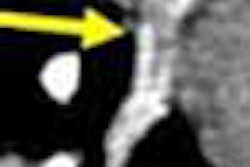Virtual colonoscopy serves up significant extracolonic findings even when acquired with a low-dose protocol, researchers in New York City reported. They also found that the cost of following up the findings is minimal, due in part to the low numbers of patients who require additional care.
"One potential advantage of CT colonography (VC) over other methods of colonic imaging, such as colonoscopy or barium enema, is the ability to detect incidental lesions (outside) the colon," wrote Dr. Roshini Rajapaksa, Dr. Michael Macari, and Dr. Edmund Bini from the VA New York Harbor Healthcare System and New York University Medical Center in New York City. "Little is known, however, about the prevalence of these incidental findings, or how frequently they result in further diagnostic testing (Journal of Clinical Gastroenterology, October 2004, Vol. 38:9, pp. 767-771).
To gauge the prevalence and significance of extracolonic findings in VC patients, and compare it to previous study findings, the team recruited 250 patients (mean age 62.5 ± 9.5 years, 245/250 male) who were referred for conventional colonoscopy and invited to add same-day virtual colonoscopy to the mix.
The cohort, dominated by military veterans, included a mix of asymptomatic screening subjects (n = 72, 28.8%), and patients with indications of elevated risk, including positive fecal occult blood test (FOBT) (n = 55, 22%), hematochezia (n = 47, 18.8%), iron-deficiency anemia (n = 33, 13.2%), history of colonic polyps (n = 25, 10%), or a change in bowel habits (n = 18, 7.2%). Patients with a history of colonic surgery were excluded.
A day before CT imaging and conventional colonoscopy, patients were given one of two cathartic laxative regimens consisting of either two 45-mL doses of sodium phosphate (Phospho-soda, Fleet Pharmaceuticals, Lynchburg, VA) or 4 L of polyethylene glycol (GoLytely, Braintree Laboratories, Braintree, MA) for cases in which the patient had ascites, renal insufficiency, or congestive heart failure, the authors wrote. The colon was insufflated manually with room air using a flexible rubber catheter.
Supine, then prone images were acquired on a multislice CT scanner at 4 x 1-mm collimation, 120 kVp, 0.5-second rotation, pitch 6-7, and 50 effective mAs. Images were reconstructed at 1-mm intervals on a Vitrea 2 workstation (Vital Images, Plymouth, MN). Conventional colonoscopy was performed immediately after the virtual exam.
A single board-certified radiologist with more than five years of experience in VC evaluated the images for extracolonic pathology, without knowledge of the patient's history or study indications.
According to the results, "one or more extracolonic findings were detected in 83 (33.2%) of the 250 patients," the authors wrote. "A total of 136 extracolonic abnormalities were found in these 83 individuals.... Of the 136 findings, 17 (12.5%) were highly significant, 53 (39.0%) were moderately significant, and 66 (48.5%) were of low significance."
The high-significance findings in 17 patients included solitary lung nodules (n = 3), mesenteric lymphadenopathy (n = 3), adrenal mass (n = 2), low-attenuation liver lesions characteristic of metastases (n = 2), multiple bone lucencies characteristic of metastases (n = 2), and a 6-cm renal mass (n = 1). Also found were a pericardial effusion, patchy opacity in the lung base consistent with effusion, retroperitoneal lymphadenopathy consistent with lymphoma, and an asymmetrical bladder wall thickening in one patient each.
Fifty-three patients had findings of moderate significance, including, most commonly, renal stones (n = 13), gallstones (n = 13), enlarged prostate (n = 5), emphysema (n = 4), bladder stones (n = 3), bronchiectasis (n = 2), umbilical hernia (n = 2), and splenomegaly (n = 2). One patient had an aneurysmal dilatation of the right common iliac artery.
Low-significance findings in 66 patients included, most commonly, renal cysts (n = 18), hiatus hernia (n = 12), hepatic cyst (11), fatty liver (8), vascular and prostate calcifications (n = 5), and pleural thickening, fibrosis, and scarring (n = 4).
The median follow-up time was 509 days. Three of the 17 highly significant findings were already known and therefore not followed up, the authors wrote. Three patients were lost to follow-up, leaving 11/17 patients who underwent further diagnostic testing. Only two patients with only moderate- or low-significance findings were examined further, the researchers wrote.
Those with lung nodules had a chest CT scan; the patients with mesentery lymphadenopathy had either abdominal ultrasound and chest x-ray, or abdominal MRI alone. One adrenal mass was further examined with MRI, and a bone scan was performed in one of the patients with bone lucencies consistent with metastasis. Following resection of the 6-cm renal mass in one patient, pathology revealed a renal cell carcinoma without evidence of metastasis, according to the authors.
"A cost of ... $7,324 was calculated for the follow-up of the extracolonic findings, with a mean additional cost of $28 per examination," the authors wrote, concluding that serious extracolonic findings can be followed up without a significant cost increase per patient. There was no significant difference in the prevalence or importance of incidental findings between screening patients and those referred for colorectal symptoms, they wrote.
The group found extracolonic abnormalities in 33.2% of patients overall, compared to 15.1% in a previous study by Edwards et al, and 41.3% in a previous study by Hara et al. Still, the proportion of patients who underwent further diagnostic examination was similar in all three studies (4.4% to 7.0%), the authors wrote (American Journal of Gastroenterology, October 2001, Vol. 96:10, pp. 3009-3012; Radiology, May 2000, Vol. 215:2, pp. 353-357).
Other abdominal studies have suggested enhanced value in incidental findings, including a 1990 ultrasound study in European Radiology. "We can conclude that incidental detection reveals renal tumors at a relatively limited stage (83% of T2), with dimensions smaller than those of the other groups," Vallancien and colleagues wrote (European Radiology 1990, Vol. 18:2, pp. 94-96).
A study by Masood and colleagues found that patients whose renal cell carcinoma was detected incidentally had a better survival rate than that of symptomatic patients (BJU International, November 2001, Vol. 88:7, pp. 671-674).
Rajapaksa et al did note several limitations of the present study, including the use of low-dose (50 mAs) scanner settings that may have caused some extracolonic pathology to be missed. Also, the relatively high mean age of the subjects (62.5) may have raised the prevalence of findings, and results for the mostly male cohort may not be generalizable to women, they wrote. Finally, they noted that while intrinsically high contrast between bowel wall and lumen may yield good results for low-dose and noncontrast studies in many cases, pathology in the surrounding solid organs may not be so easily discovered with a colon imaging protocol.
"Although highly significant extracolonic lesions were uncommon in our study, they did result in further diagnostic testing in a minority of patients," the authors concluded. "More importantly, low or moderately significant extracolonic findings did not result in unnecessary diagnostic testing or procedures. Additional studies to determine the optimal radiation dose, cost-effectiveness, and legal implications of failing to detect extracolonic findings are warranted."
By Eric Barnes
AuntMinnie.com staff writer
September 21, 2004
Related Reading
What virtual colonoscopy misses might not matter, August 18, 2004
Workflow issues key in virtual colonoscopy, January 15, 2003
In VC, extracolonic findings offer valuable information at little extra cost, June 3, 2002
Copyright © 2004 AuntMinnie.com




















